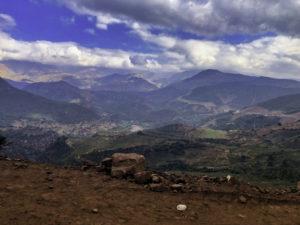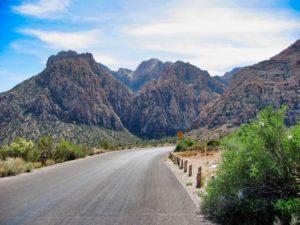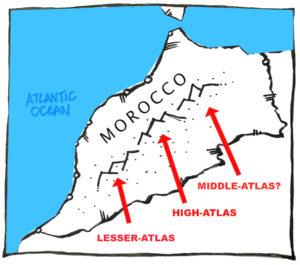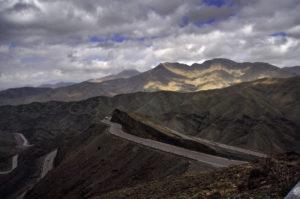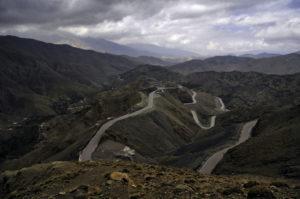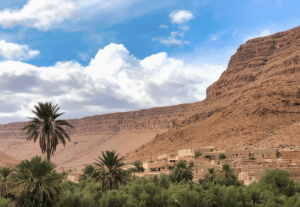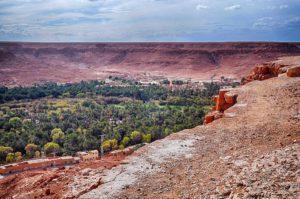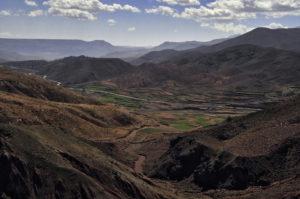On a continent where deserts like the Kalahar, Namib, and Sahara routinely scorch roughly one-fourth of its total land, Africa's Atlas Mountains—with their higher altitudes and cooler temperatures—are a welcome respite from the continent's usual blast-furnace-based climate. We didn't expect the range to be much more than a nice change of scenery, but damned if that adorable cordillera didn't charm our pants off.
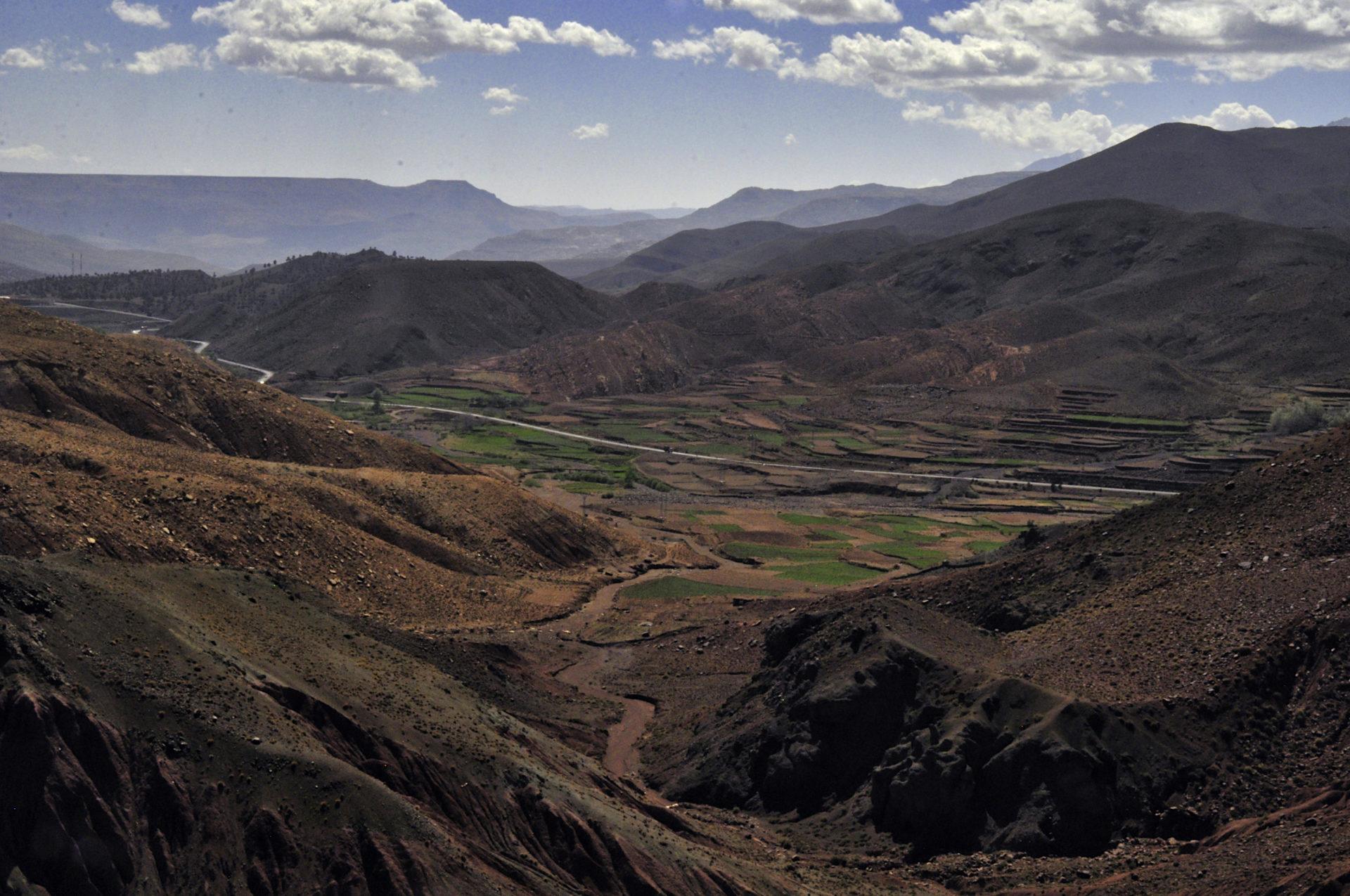
Wait, where are the Atlas Mountains again?
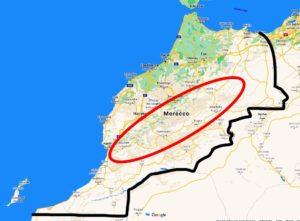
The Atlas Mountains basically cut a horizontal East/West swath through the middle of Morocco (see photo), a country situated in the top-left tip of the African Continent.
To the northwest of the mountains, along the Atlantic Ocean and Alboran Sea, lay most of Morocco's major cities (including Marrakech, Tangier, and Chefchaouen), as well as towns, factories, and farmland. To the southeast of the mountains, there's…well, sand. Just sand.
How much sand? Like, tons of it. If I had to guess how much, I'd say enough to cover half of Montana. That's probably more desert than Moroccans really wanted when desert was first doled out by the Zoning Gods, but what are they going to do about it now? Ask for a variance? Yeah, I wish 'em good luck with that.
The Atlas Mountains are kinda like a lot of other ranges.
As a couple of fairly avid travelers, my wife and I have already been to a number of mountain ranges, including the Andes, the Adirondacks, the Sierra Nevadas, the Alaskas, the Rockies, and even China's Yan, so we somewhat understand the appeal of living life at a 45° angle, far from fanatical flatlanders.
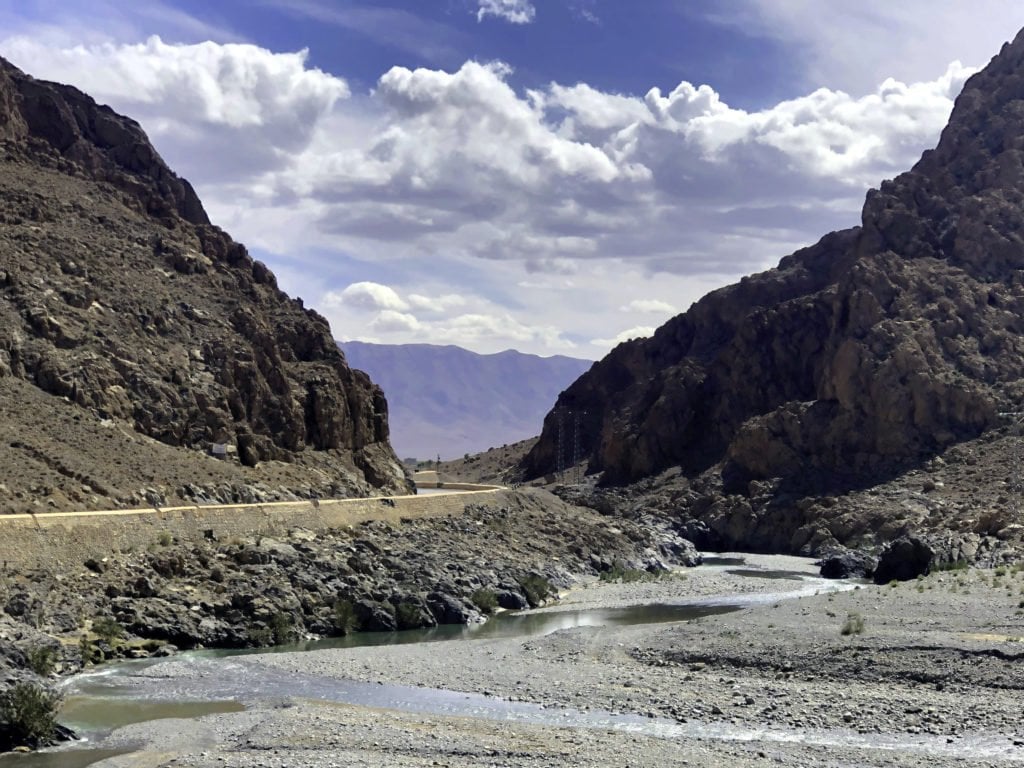
One might assume, therefore, that if you've seen one mountain range, you've seen them all. But that's the type of narrow-minded, judgmental arrogance that only reinforces the Atlas Mountains' negative body-image and exacerbates its self-esteem issues.
Inanimate geological formations have feelings, too, you know.
When the Atlas Mountains were formed some 300 million years ago during the Paleozoic Era—back when North America, Europe, and Africa got all drunk and hooked up—the Atlas mountains rivaled today's Himalayas in size and so, not surprisingly, it got laid constantly. This was common knowledge back then because the Atlas chain would never shut up about it.

But, over the eons, the three continents began bickering a lot, finally breaking up and moving far away from each other. That left the Atlas Mountains sad and alone. A mere shadow of its former continental self, quietly sobbing over old photos, love letters, and the remains of its once-respectable CD collection.
After the trauma of being rejected and abandoned like that, developing an inferiority complex would be more than understandable.
Morocco's tallest mountain is, frankly, not all that tall.
Today, the Atlas Mountains are all but neglected by both suitors and the record books. At an almost embarrassing peak-height of just 13,671-feet, its Toubkal Ridge outside of Marrakesh is now barely half the height of the tectonic titans on the world's “Top 100 Tallest Mountains” list—a precipitous fall from grace for this once-dominant stack of stones.
The Andes is the longest range at 4,000+ miles and has the second-highest peak at 22,838 feet.
—its parents must be very proud
To minimize further parental disappointment, however, the Atlas Mountains wisely opted to refocus its energies on length instead of height, a criterion for which the range comports itself far better. Not only does the Atlas Mountains make the Top 100 list, it even makes the Top 10 in the length category (right up there alongside John Holmes).
Size isn't everything, but it's certainly not nothing.
As the world's ninth-longest range, the Atlas Mountains measure a respectable 1,600 miles from end to end, about the distance from NYC to Houston, London to Kyiv, Ukraine, or Karachi, Pakistan to Bangladesh.
It would take you over 540 hours to walk the whole stretch, assuming you couldn't get an Uber® (which you can't because the car-sharing service is currently only available in Casablanca).
Over that vast expanse of rocky real estate, the Atlas chain is artificially divided into three sections. To the West, there's the Lesser-Atlas Mountains. To the East, there's the Middle-Atlas Mountains.
And between the two are…uh, the High-Atlas Mountains…kinda jammed in the…um, middle…you know, between the Lesser and…uh, the Middle. Get it? Cool, now you can explain it to me.
The Atlas Mountains still have it going on…and on, and on.
When it comes to looks, the Atlas Mountains are nothing to sneeze at. Though, why you'd “sneeze” at something instead of maybe “sneering” at it, is beyond me—I feel like that phrase got “grape-vined” at some point. Or maybe not.
Regardless, the range is an impressive sight any way you look at it (I recommend using your eyes). Around each snaking bend is yet another mesmerizing mountain vista, uncorrupted by shopping malls, iPhone factories, housing developments, or almost any other sign of civilization (so bring a large empty Gatorade® bottle along in case you need to pee).
Instead, there's a never-ending rock rainbow of every color and hue imaginable, though there's a definite emphasis on earth tones. Trying to take in the full width and breadth of the Atlas Mountains is challenging, as it will eventually exhaust your eye's cones and rods.
Staring at the landscape for too long can be visually painful and—if you're driving at the time—potentially fatal because highways like Morocco's N13 have a ton of sudden switchbacks and a disconcerting lack of metal guardrails (see video below).
The Ziz River is important to locals because you can't farm rock.
The denizens of the High Atlas range don't build their homes nestled up amongst the valley's angled mountainsides just for the spectacular views or to defend themselves against encroaching hordes of marauding flatlanders. No, they build homes up there because land at the base of the mountains is better used for other purposes.
With precipitation rates that rarely exceed ten or eleven inches a year(!), Moroccans have to farm where the water is and, in the High Atlas Mountains, that's on the valley floor along the twisting banks of the temperamental Ziz River.
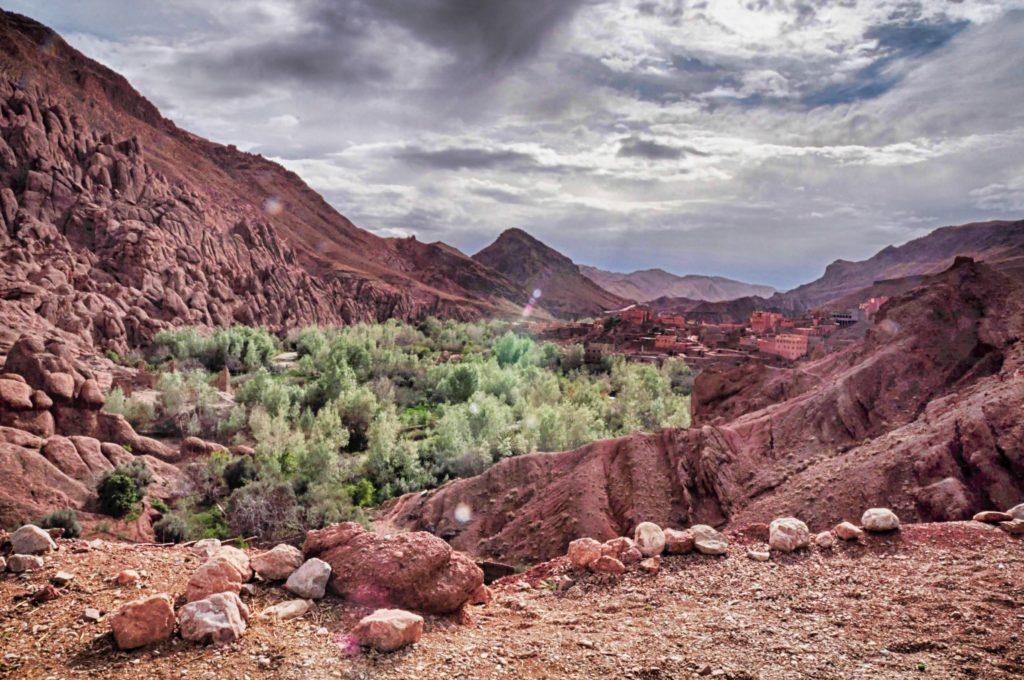
Tiny streams flowing from higher mountain springs come together to create this vital waterway that runs through the entire Atlas valley all the way to the Sahara Desert some 200 miles away. The river fuels almost all the farms in the High Atlas Mountains, powers a hydroelectric dam, and attracts tourists looking to take stark and powerful landscape photos like the ones you see on this page (contact me for licensing terms).
While most of the surrounding area is composed of bedrock, brush, and beer cans, the Ziz River gorges veritably explode with vibrant greenery against the otherwise beige sand-scape. This path of lush foliage is the only visible sign of the almond trees, olive trees, date palms, cereals, alfalfa fields, and other cash crops that grow along the Ziz River's shore.
With hardly anything else visible for miles around, these narrow, meandering groves seem almost illicit, like the secret marijuana farms of Humboldt County, or the alien clone farms of Area 51. The remoteness of these Ziz River farms made me wonder if they were being run illegally under the jackbooted cruelty of Morocco's merciless Alfalfa Mafia. And, to be honest, I have no proof that they're not.
Why you've never heard of this Moroccan mountain range before.
The Atlas Mountains aren't as well-known to the general public—and by that, I mean, Americans—as the Himalayas, Appalachians, or Andes, mostly because the range rarely makes the news in the US. Maybe if more American tourists died after climbing it, getting lost on it, or crashing a small plane into it, the chain would be a more popular tourist destination.
Yet, even though they clearly don't have a great PR agency, the Atlas Mountains are nonetheless worth visiting or at least knowing about for no other reason than winning the Jeopardy® game show by confidently stating, “I'll take Lesser Known Mountain Ranges for 400, Alex.”
That would be totally worth it, in my opinion.

